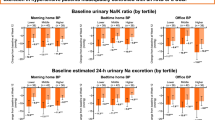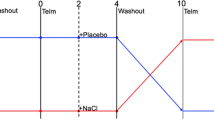Abstract
Backgrounds
The inhibition of the renin-angiotensin system in the diabetic condition was reported to enhance the sodium sensitivity of blood pressure. In patients with sodium-sensitive hypertension, high sodium intake reduces the nocturnal fall in blood pressure. Therefore, we examined the effects of the amount of sodium intake or diuretics in patients with diabetes treated with an angiotensin receptor blocker.
Methods
We recruited 32 Japanese type 2 diabetic patients with base line blood pressure ≥130/80 mmHg and treated with valsartan (80 mg daily). At baseline, 24-h ambulatory blood pressure and 24-h urinary excretion of sodium were measured. The patients were then randomly assigned to take either combination therapy with 50 mg of losartan plus 12.5 mg of hydrochlorothiazide or monotherapy with 160 mg of valsartan for 24 weeks.
Results
At baseline, 22 of 32 (69%) patients were classified as non-dippers, and the night/day ratio of mean arterial pressure was significantly correlated with 24-h urinary sodium excretion. The combination therapy resulted in a significantly higher fall than the monotherapy in 24-h mean, daytime, night-time and morning blood pressures. The night/day ratio of mean arterial pressure was significantly reduced from the baseline at the end of the study in the combination therapy group, but not in the monotherapy group. In non-dipper patients, the diminished nocturnal fall in blood pressure was restored by the combination therapy.
Conclusions
Excessive intake of salt causes non-dipping and diuretics restored nocturnal BP fall in type 2 diabetic patients treated with angiotensin 2 receptor blockers.




Similar content being viewed by others
References
Chobanian AV, Bakris GL, Black HR, Cushman WC, Green LA, Izzo JL Jr, et al. The Seventh Report of the Joint National Committee on prevention, detection, evaluation, and treatment of high blood pressure: the JNC 7 report. JAMA. 2003;289:2560–72.
Japanese Society of Hypertension. Japanese Society of Hypertension guidelines for the management of hypertension (JSH 2004). Hypertens Res. 2006;29:S1–105.
Mancia G, De Backer G, Dominiczak A, Cifkova R, Fagard R, Germano G, et al. 2007 ESH-ESC Practice guidelines for the management of arterial hypertension: ESH-ESC task force on the management of arterial hypertension. J Hypertens. 2007;25:1751–62.
Brenner BM, Cooper ME, de Zeeuw D, Keane WF, Mitch WE, Parving HH, et al. Effects of losartan on renal and cardiovascular outcomes in patients with type 2 diabetes and nephropathy. N Engl J Med. 2001;345:861–9.
Parving HH, Lehnert H, Bröchner-Mortensen J, Gomis R, Andersen S, Arner P. The effect of irbesartan on the development of diabetic nephropathy in patients with type 2 diabetes. N Engl J Med. 2001;345:870–8.
Viberti G, Wheeldon NM. Microalbuminuria reduction with valsartan in patients with type 2 diabetes mellitus: a blood pressure-independent effect. Circulation. 2002;106:672–8.
Garg JP, Bakris GL. Microalbuminuria: marker of vascular dysfunction, risk factor for cardiovascular disease. Vasc Med. 2002;7:35–43.
Gerstein HC, Mann JF, Yi Q, Zinman B, Dinneen SF, Hoogwerf B, et al. Albuminuria and risk of cardiovascular events, death, and heart failure in diabetic and nondiabetic individuals. J Am Med Assoc. 2001;286:421–6.
Rocchini AP, Key J, Bondie D, Chico R, Moorehead C, Katch V, et al. The effect of weight loss on the sensitivity of blood pressure to sodium in obese adolescents. N Engl J Med. 1989;322(7):476–7.
Uzu T. Circadian rhythm of blood pressure and cardiovascular risk in sodium sensitive hypertension. Clin Exp Nephrol. 1999;3:229–36.
Uzu T, Kimura G, Yamauchi A, Kanasaki M, Isshiki K, Araki S, et al. Enhanced sodium sensitivity and disturbed circadian rhythm of blood pressure in essential hypertension. J Hypertens. 2006;24:1627–32.
Rocchini AP. The relationship of sodium sensitivity to insulin resistance. Am J Med Sci. 1994;307:S75–80.
Wedler B, Wiersbitzki M, Gruska S, Wolf E, Luft FC. Definitions and characteristics of sodium sensitivity and blood pressure resistance. Hypertension. 1986;8:127–34.
Fuenmayor N, Moreira E, Cubeddu LX. Salt sensitivity is associated with insulin resistance in essential hypertension. Am J Hypertens. 1998;11:397–402.
Hall JE, Guyton AC, Smith MJ Jr, Coleman TG. Chronic blockade of angiotensin II formation during sodium deprivation. Am J Physiol. 1979;237:F424–32.
Uzu T, Ishikawa K, Fujii T, Nakamura S, Inenaga T, Kimura G. Sodium restriction shifts circadian rhythm of blood pressure from nondipper to dipper in essential hypertension. Circulation. 1997;96(6):1859–62.
Staesssen JA, Thijs L, Fagard R, O’Brien ET, Clement D, de Leeuw PW, et al. Predicting cardiovascular risk using conventional vs. ambulatory blood pressure in older patients with systolic hypertension. JAMA. 1999;282:539–46.
Sega R, Facchetti R, Bombelli M, Cesana G, Corrao G, Grassi G, et al. Prognostic value of ambulatory and home blood pressures compared with office blood pressure in the general population: follow-up results from the Pressioni Arteriose Monitorate e Loro Associazioni (PAMELA) study. Circulation.. 2005;111:1777–83.
Boggia J, Li Y, Thijs L, Hansen TW, Kikuya M, Björklund-Bodegard K, et al. Prognostic accuracy of day versus night ambulatory blood pressure: a cohort study. Lancet. 2007;370:1219–29.
Mogensen CE, Viberti G, Halimi S, Ritz E, Ruilope L, Jermendy G, et al. Effect of low-dose perindopril/indapamide on albuminuria in diabetes: preterax in albuminuria regression: PREMIER. Hypertension. 2003;41:1063–71.
Uzu T, Harada T, Namba T, Yamamoto R, Takahara K, Yamauchi A. Thiazide diuretics enhance nocturnal blood pressure fall and reduce proteinuria in immunoglobulin A nephropathy treated with angiotensin II modulators. J Hypertens. 2005;23:861–5.
Kario K, Pickering TG, Umeda Y, Hoshide S, Hoshide Y, Morinari M, et al. Morning surge in blood pressure as a predictor of silent and clinical cerebrovascular disease in elderly hypertensives: a prospective study. Circulation. 2003;107:1401–6.
Peralta CA, Hicks LS, Chertow GM, Ayanian JZ, Vittinghoff E, Lin F, et al. Control of hypertension in adults with chronic kidney disease in the United States. Hypertension.. 2005;45:1119–24.
Uzu T, Kimura G. Diuretics shift circadian rhythm of blood pressure from nondipper to dipper in essential hypertension. Circulation. 1999;100(15):1635–8.
O’Brien E, Scheridan J, O’Malley K. Dippers and non-dippers. Lancet. 1988;13:397.
Verdecchia P, Porcellatim C, Schillaci G, Borgioni C, Ciucci A, Battistelli M, et al. Ambulatory blood pressure. An independent predictor of prognosis in essential hypertension. Hypertension. 1994;24:793–801.
Kario K. Time for focus on morning hypertension: pitfall of current antihypertensive medication. Am J Hypertens. 2005;18:149–51.
Tweeddale MG, Ogilvie RI, Ruedy J. Antihypertensive and biochemical effects of chlorthalidone. Clin Pharmacol Ther. 1977;22:519–27.
Shahinfar S, Simpson RL, Carides AD, Thiyagarajan B, Nakagawa Y, Umans JG, et al. Safety of losartan in hypertensive patients with thiazide-induced hyperuricemia. Kidney Int. 1999;56:1879–85.
Enomoto A, Kimura H, Chairoungdua A, Shigeta Y, Jutabha P, Cha SH, et al. Molecular identification of a renal urate anion exchanger that regulates blood urate levels. Nature. 2002;23:447–52.
Fogari R, Zoppi A, Mugellini A, Preti P, Banderali A, Pesce RM, et al. Comparative efficacy of losartan and valsartan in mild-to-moderate hypertension. Results of 24-hour ambulatory blood pressure monitoring. Curr Ther Res. 1999;60:195–206.
Author information
Authors and Affiliations
Corresponding author
Additional information
An erratum to this article can be found at http://dx.doi.org/10.1007/s10157-009-0185-3
About this article
Cite this article
Uzu, T., Sakaguchi, M., Yokomaku, Y. et al. Effects of high sodium intake and diuretics on the circadian rhythm of blood pressure in type 2 diabetic patients treated with an angiotensin II receptor blocker. Clin Exp Nephrol 13, 300–306 (2009). https://doi.org/10.1007/s10157-009-0157-7
Received:
Accepted:
Published:
Issue Date:
DOI: https://doi.org/10.1007/s10157-009-0157-7




